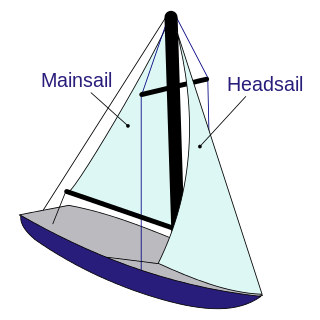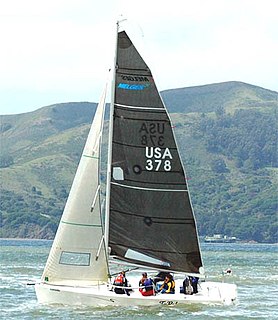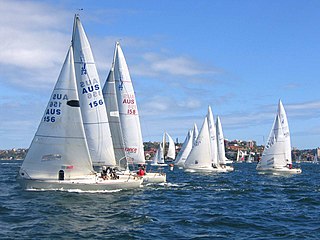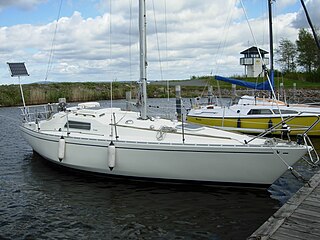
A sailboat or sailing boat is a boat propelled partly or entirely by sails and is smaller than a sailing ship. Distinctions in what constitutes a sailing boat and ship vary by region and maritime culture.

Yacht racing is a sailing sport involving sailing yachts and larger sailboats, as distinguished from dinghy racing, which involves open boats. It is composed of multiple yachts, in direct competition, racing around a course marked by buoys or other fixed navigational devices or racing longer distances across open water from point-to-point. It can involve a series of races when buoy racing or multiple legs when point-to-point racing.

A maxi yacht usually refers to a racing yacht of at least 21 metres (70 ft) in length.

The Rolex Sydney Hobart Yacht Race is an annual event hosted by the Cruising Yacht Club of Australia, starting in Sydney, New South Wales, on Boxing Day and finishing in Hobart, Tasmania. The race distance is approximately 630 nautical miles (1,170 km). The race is run in conjunction with the Royal Yacht Club of Tasmania, and is widely considered to be one of the most difficult yacht races in the world.

The Fastnet Race is a biennial offshore yacht race organised by the Royal Ocean Racing Club of the United Kingdom with the assistance of the Royal Yacht Squadron in Cowes and the Royal Western Yacht Club in Plymouth.
One-Design is a racing method which may be adopted in sports which use complex equipment, whereby all vehicles have identical or very similar designs or models.
The International Offshore Rule (IOR) was a measurement rule for racing sailboats. The IOR evolved from the Cruising Club of America (CCA) rule for racer/cruisers and the Royal Ocean Racing Club (RORC) rule.

The Contessa 32 is a 9.75 metre (32 ft) fibreglass monohull sailing yacht, designed in 1970 by David Sadler in collaboration with yachtbuilder Jeremy Rogers, as a larger alternative to the Contessa 26. With over 750 hulls built, the yacht has become the most successful one-design cruiser-racer of all time. The yachts have a masthead sloop rig, with a fin keel and a skeg-mounted rudder, a cutting edge concept for the period which now represents a cross between newer and older designs.

A sailing yacht, is a leisure craft that uses sails as its primary means of propulsion. A yacht may be a sail or power vessel used for pleasure, cruising, or racing. There is no standard definition, so the term applies here to sailing vessels that have a cabin with amenities that accommodate overnight use. To be termed a "yacht", as opposed to a "boat", such a vessel is likely to be at least 33 feet (10 m) in length and have been judged to have good aesthetic qualities. Sailboats that do not accommodate overnight use or are smaller than 30 feet (9.1 m) are not universally called yachts. Sailing yachts in excess of 130 feet (40 m) are generally considered to be superyachts.

The Royal Ocean Racing Club is a club in London with a further clubhouse and office in Cowes, Isle of Wight. It was established in 1925 as the Ocean Racing Club, as a result of a race to the Fastnet Rock from Cowes, finishing in Plymouth. It received royal approval by King George V in November 1931 since when it has been known as the Royal Ocean Racing Club.
The International Measurement System (IMS) is a system of handicapping sailboats for the purpose of racing that replaced the earlier International Offshore Rule (IOR) system in the early 1990s. It is managed by the Offshore Racing Congress (ORC). In the sailing world it is usually referred to simply as 'IMS'.
The Launceston to Hobart yacht race is a 285 nautical mile race, commencing at Beauty Point on the Tamar River, with competitors sailing out of the Tamar River, east along the northern coast of Tasmania, through Banks Strait and south down Tasmania's East Coast, through Mercury Passage between mainland Tasmania and Maria Island, across Storm Bay, to a finish line in the Derwent River. The race departs on 27 December each year. The race is known as the L2H race despite the race commencing at Beauty Point, some 45 kilometers north of Launceston.

The term sportsboat first appeared in the late 1980s and early 1990s to describe trailer sailers that were optimised for high performance at the expense of accommodation and ballast. The very definition of the term "sportsboat" is evolving.

The Annual Bay to Bay Trailable Yacht Race is an annual sailing event for monohull and multihull trailable yachts conducted by the Hervey Bay Sailing Club on the first weekend in May each year through the Great Sandy Marine Park and past the Great Sandy National Park and the World Heritage-listed Fraser Island. The race is sailed from Tin Can Bay to Hervey Bay through the Tin Can Bay Inlet and the Great Sandy Strait and into Hervey Bay with an overnight stop at Garry's Anchorage between Fraser Island and Stewart Island. The race is Queensland's largest trailable yacht race and one of the three largest trailable yacht passage races in Australia.
The Offshore Racing Congress Rule is a system of handicapping sailboats for the purpose of racing. It is managed by the Offshore Racing Congress (ORC) and is usually referred to in the sailing community simply as "ORC". ORC is an enhanced version of the earlier IMS handicapping system that was used globally from the early 1990s to the early 2000s.

The sport of sailing involves a variety of competitive sailing formats that are sanctioned through various sailing federations and yacht clubs. Racing disciplines include matches within a fleet of sailing craft, between a pair thereof or among teams. Additionally, there are specialized competitions that include setting speed records. Racing formats include both closed courses and point-to-point contests; they may be in sheltered waters, coast-wise or on the open ocean. Most competitions are held within defined classes or ratings that either entail one type of sailing craft to ensure a contest primarily of skill or rating the sailing craft to create classifications or handicaps.
The Offshore Racing Congress (ORC) is an international body for the sport of competitive sailing and is responsible for the establishment and maintenance of rating and classification standards used to define offshore, that is marine as opposed to inland, yacht racing handicap categories.

The Union Nationale pour la Course au Large also called UNCL is a French yacht club

Half Ton class was an offshore sailing class of the International Offshore Rule racing the Half Ton Cup between 1967 and 1993.
Handicap forms for sailing vessels in sailing races have varied throughout history, and they also vary by country, and by sailing organisation. Sailing handicap standards exist internationally, nationally, and within individual sailing clubs.